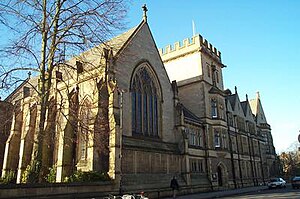Harris Manchester College
| Harris Manchester | |
|---|---|
 |
|

Blazon: Gules two torches inflamed in saltire proper, on a chief argent, between two roses of the field barbed and seeded, an open book also proper.
|
|
| University | University of Oxford |
| Coordinates | 51°45′21″N 1°15′07″W / 51.755758°N 1.252044°WCoordinates: 51°45′21″N 1°15′07″W / 51.755758°N 1.252044°W |
| Full name | Manchester Academy and Harris College |
| Latin name | Collegium de Harris et Manchester |
| Motto | Veritas Libertas Pietas (Truth, Freedom, Piety) |
| Established | 1786 |
| Named for | Philip Harris, Baron Harris of Peckham |
| Sister college | Homerton College, Cambridge |
| Principal | The Revd Ralph Waller |
| Undergraduates | 79 |
| Postgraduates | 116 |
| Website | www |
| Map | |
Harris Manchester College is a constituent college of the University of Oxford in the United Kingdom. Formerly known as Manchester College, it is listed in the University Statutes (V.1) as Manchester Academy and Harris College, and at university ceremonies it is called Collegium de Harris et Manchester. Located in Mansfield Road in central Oxford, Harris Manchester is one of very few mixed-sex higher education colleges in the UK whose undergraduate places are exclusively for students aged 21 or over. It is the smallest of the constituent full colleges of the University of Oxford, and as of 2012 had an estimated financial endowment of £6 million.
The college started as the Warrington Academy in 1757 where its teachers included Joseph Priestley, before being refounded as the Manchester Academy in Manchester in 1786. Originally run by English Presbyterians, it was one of several dissenting academies that provided religious nonconformists with higher education, as at the time the only universities in England - Oxford and Cambridge - were restricted to Anglicans. It taught radical theology as well as modern subjects, such as science, modern languages, language, and history; as well as the classics. Its most famous professor was John Dalton, developer of atomic theory.
The college changed its location five times before settling in Oxford. It was located in Manchester between 1786 and 1803. It moved to York until 1840. It was located at 38 Monkgate, just outside Monkbar; later this was the first building of the College of Ripon and York St John (now York St John University).The key person in York was Charles Wellbeloved, a Unitarian minister. Because he would not move to Manchester, the college moved to York to have him as head. At first he taught all subjects, but hired additional tutors after a year. He always worked hard and several times his health broke. Wellbeloved did not allow the school to be called Unitarian because he wanted students to have an open mind and to discover the truth for themselves. In 1809 he wrote to George Wood,
...
Wikipedia

